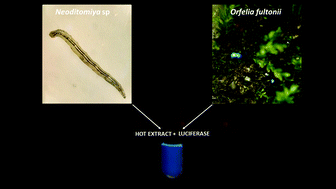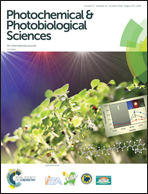Orfelia-type luciferin and its associated storage protein in the non-luminescent cave worm Neoditomyia sp. (Diptera: Keroplatidae) from the Atlantic rainforest: biological and evolutionary implications
Abstract
Bioluminescence in Diptera is found in the family Keroplatidae, in the glowworms of the genera Arachnocampa, Orfelia and Keroplatus. Despite belonging to the same family, Arachnocampa spp. and Orfelia fultoni display morphologically and biochemically distinct bioluminescence systems: Arachnocampa spp. produce light by the terminal ends of Malpighian tubules using ATP, a luciferin and a luciferase, whereas Orfelia fultoni produces light by translucent areas associated with rows of black bodies in the anterior and posterior parts of the body, using a 140 kDa luciferase and a luciferin which do not cross-react with the Arachnocampa luciferin–luciferase system, and a substrate binding fraction (SBF) which apparently releases luciferin in the presence of reductants. While several other keroplatids are not luminescent, we recently discovered a non-luminescent web-constructing keroplatid larva living in the roofs of caves in the Atlantic rainforest in Brazil, which noteworthily has a compound with Orfelia luciferin-like activity and its associated binding protein (SBF). Both the Neoditomyia luciferin-like compound and SBF cross-react with purified Orfelia luciferase to produce light in the same blue region of the Orfelia luciferin–luciferase system (479 nm). We also checked for the presence of Orfelia-type luciferin in Arachnocampa luminosa and Aedes aegytpi larval bodies, but no traces were found. Molecular studies indicate that Neoditomyia sp. is phylogenetically closer to Keroplatus and Orfelia than to Arachnocampa species. The presence of luciferin and its associated binding protein in this non-bioluminescent keroplatid larva indicates that luciferin may display another important biochemical function in keroplatid larvae and suggests that bioluminescence could be a recently evolved trait in Keroplatidae.



 Please wait while we load your content...
Please wait while we load your content...